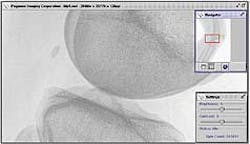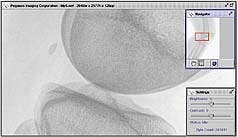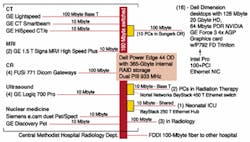Wavelet compression aids image distribution
By R. Winn Hardin,Contributing Editor
Rick Rogers, head of the Central Methodist Hospital (Memphis, TN) radiology IT department, spent months evaluating Picture Archiving and Communications Systems (PACS) only to have radiologists reject a filmless image-distribution method. Unfortunately, the radiology department's reticence did not solve the image-distribution problems experienced by other medical departments. Surgeries were being delayed because medical film was not available in the operating room; radiation therapy and pediatric intensive-care units also had film problems. "The first need of doctors outside radiology was mobility. We've grown to the point that the film needs to be in several places at the same time," says Rogers.
While exploring centralized digital image-distribution systems, Rogers had an opportune meeting with Merge Technologies (Milwaukee, WI). The meeting prompted several software houses to develop a client/server image-distribution package that would work with Central Methodist's existing IT network. This package included data pipes of varying bandwidth from a 100-Mbit/s fiber distributed-data interface (FDDI) to a 10-Mbit/s shared Ethernet. The consensus was that image compression and decompression had to be part of the image-distribution system, or physicians using shared Ethernet connections would soon tire of slow downloads.
With these requirements in mind, a software product called MergeView was developed that incorporated dynamic transmission and wavelet compression libraries, such as those from Pegasus Imaging Corp. (Tampa, FL; see Fig. 1). In addition, it included an inexpensive and robust client-side image-viewing package for a shareware workstation viewer from eFilm Medical Inc. (Toronto, Ont., Canada). MergeView software aims to remove the financial and physical barriers to medical image-distribution systems by incorporating dynamic wavelet decompression with a server/client platform that gives file access to all users simultaneously.
FIGURE 1. Using wavelet compression, a server stores a minimum-resolution image and compresses the additional data using a wavelet transform. The server then sends the minimum-resolution picture immediately and fills in the picture over time until either the user decides on an acceptable resolution or receives the entire image file. In the knee x-ray, the small thumbnail (far right), indicates the region of interest. The Pegasus software requests coefficients for pixels in the region of interest and then fills in the additional details outside the region of interest.
Bill Mortimer, chairman and chief strategy officer at Merge Technologies, understands physicians' skepticism when it comes to large, expensive PACS networks. These systems typically required expensive workstations and high-bandwidth networks. And retrofitting hospital and outpatient facilities with fiberoptic backbone or Gigabit Ethernet networks is too costly for small medical facilities.
Another system approach uses autorouting technology, where clinicians can view images at certain workstations at certain times. This means, in theory, that clinicians could show up at a scheduled time and view their scheduled exams on screen without waiting for long downloads. Unfortunately, as patients can attest, medical procedures tend not to follow set schedules. Likely as not, Mortimer says, a physician that wants to review exams from a different workstation would still have to wait for downloads.
TESTBEDCentral Methodist's Rogers convinced Merge Technologies that his hospital's existing facilities could serve as an excellent testbed for MergeView. Central Methodist is one of five affiliated hospitals in Memphis interested in future technology growth and enterprise testing. All the modalities (imaging systems) at Central Methodist were already using digital equipment, and the five hospitals were already communicating across a TCP/IP network. A dedicated 100-Mbit/s FDDI provided a fiberoptic backbone network for the five hospitals.Internally, Central Methodist had installed a mixture of 100- and 10-Mbit/s switched Ethernet networks and a 10-Mbit/s shared Ethernet network. Moreover, the hospital workstations were standard Dell Computer (Round Rock, TX) Dimension PCs. They included 600-MHz Pentium III microprocessors, 128 Mbytes of RAM, 20-Gbyte hard drives, Nvidia (Santa Clara, CA) GeForce 3 graphics cards, and Sony (Park Ridge, NJ) 17-in. 792 FD Trinitron monitors running on a mixture of Windows 95/NT software.
Central Methodist was using Unix-based hardware and software extensively. This equipment was readily adapted to server software on a Dell PowerEdge 4400 server with 365 Gbytes of internal RAID storage using RedHat (Durham, NC) Linux software (see Fig. 2).
Central Methodist's radiology department had previously determined that a stand-alone PACS was not for them. As proposed, the MergeView program would only serve departments outside radiology, departments that were already underserved and clamoring for help. MergeView would mean Rogers could improve the hospital's operations without having to internally develop a costly image-distribution system. Rogers felt that after successful MergeView installation and operation, clinicians outside the radiology department might convince the radiologists that digital image distribution was cost-effective.
PROVIDERS WORK TOGETHERMergeView is a customized combination of five software products from four separate vendors. eFilm Medical, which partnered with Merge Technologies to develop MergeView, used C++ to modify its Workstation 1.6 image viewer to include Pegasus Imaging Image Delivery Protocol (IDP) and PICTools medical compression toolkit. Merge Technologies also used C++ to link its image-server program, which includes a 32-bit relational database for patient data—Velocis from Birdstep Technology (Seattle, WA)—to IDP and PICTools modules as well as to a Merge Technologies MergeCOM-3 integrator toolkit for uncompressed digital imaging and communications in medicine (DICOM) support. The resulting OEM-targeted series of client/server libraries that connect the MergeView server program with the IDP and wavelet-compression technologies and with the eFilm client program is all referred to as the Image Channel Library.Rogers was initially concerned by Merge Technologies' decision to go with the little-known Velocis database. But since the DICOM data were stored at the local modalities, data loss was not a problem. Merge Technologies' Mortimer maintains that Velocis offers all the features MergeView needs from a database and is considerably cheaper than Oracle software or other leading database programs.
The database did suffer some problems during early trials. For several months, Merge Technologies had to tweak the database control code to minimize access times. Rogers adds, "When we had 1000 studies in the database, it was a screamer. But when we got to 10,000 exams, we began to see a different type of performance, and other effects showed up. Now, we're averaging 15,000 studies on-line at a time, and it's stable and back to being a screamer."
The varying bandwidths of the hospital network, including future efforts to make exams available to clinicians at their home offices across modem-speed connections, meant that image compression would be needed. Rogers believed that wavelet compression represented the best method for a dynamic image-distribution system. He said that standard compression schemes, such as JPEG, could be configured to send images at different compression levels to adjust to changing transmission speeds. However, a system built on JPEG compression would have to store the original image, determine the bandwidth, determine the compression ratio to deliver an image with an 'acceptable time frame,' and then send the image. If the software chose too high of a compression ratio for the physician's needs, the software would have to start the process all over again.
After evaluation, Pegasus Imaging wavelet-compression software was selected. Wavelet compression is similar to JPEG software except that it works on the entire image rather than on 8 x 8-pixel blocks. It takes an image and averages pairs of neighboring pixels. The resulting average is then subtracted from the original pixel color value, which is typically zero. This process continues in steps until an image has reached a preset minimum number of pixel values. The differences are then stored in reverse values. A blurry minimum-size image is initially transmitted and then the difference values are added back in, which doubles the number of pixels each time a new set of difference values arrive.
FIGURE 2. The FDDI 100-Mbyte dedicated fiberoptic line connects Methodist Central Hospital to four affiliated clinics and hospitals in the Memphis area. It is not directly connected to the network elements involved in the MergeView trial at Methodist Central. Neonatal ICU represents the slowest connection through the Nortel Networks Baystack 250 Ethernet Hub. The recently networked surgical operating rooms all have 100-Mbyte switched Ethernet capabilities controlled through the Nortel Networks 450T Ethernet switch.
This image-processing technique enables the server to compress the images. Using lossless compression does not reduce the size of the file, but it does allow for dynamic transmission. The clinician initially receives a highly compressed and blurry picture. Then the image slowly gains in resolution. The clinician can stop the imaging process whenever the resolution reaches a sufficient level. Once the image reaches sufficient resolution, the user can halt the transfer and move on to the next image.
IDP software builds on this concept through its C++ integration with the eFilms workstation software. For instance, a clinician requests a computed-tomography (CT) scan composed of 100 axial images. The clinician already knows that the problem is located between images 48 and 52, based on the original diagnosis. As the exam arrives at the workstation, 100 blurry images are stacked or tiled across the screen depending on the clinician's request. As the clinician selects picture 48, the IDP software dynamically reacts, asking the server to send coefficients for image 48 first. While the clinician reviews image 48 in greater detail, more wavelet coefficients are transmitted to the workstation for the remaining images. According to both Rogers and Mortimer, this dynamic transmission approach means that clinicians at Central Methodist Hospital typically wait four seconds or less to begin viewing an exam, regardless of the bandwidth to the PC.
CLIENT-SERVER EVOLUTIONCentral Methodist's radiology department uses 15 digital modalities, including GE Medical Systems (Waukesha, WI) CT systems such as the LightSpeed, CTi Smartbeam, and HiSpeed CT/e; a pair of GE 1.5T Signa magnetic-resonance imagers; four Fuji (Stamford, CT) FCR 500 computed radiography machines; four GE Logiq 700 Pro ultrasound imagers: and a collection of PET/SPECT imagers, such as Siemens Medical (Malvern, PA) e.cam duet, and GE Discovery V. As an exam is completed, a DICOM version of the digital file is sent to the PowerEdge server and to local storage at the workstation that accompanies the modality. MergeView calls the PICTools wavelet-compression engine to preprocess the image data using a lossless technique. The compressed version of the picture is stored in 365 Gbytes of RAID storage inside the PowerEdge 4400 server. At the same time, MergeView strips the DICOM header, including patient and exam data, and stores the remaining information in the Velocis database along with the compressed images' location on the RAID drive.Because the modalities—not the RAID drives—are the main archive devices, the server only needs to hold a few months of exam data. A true mini-PACS would require additional on-line archives, explains Merge Technologies' Mortimer.
The eFilm image viewer resides in 16 desktop PCs around the hospital, including 10 on 100-Mbyte switched Ethernet network nodes that serve the hospital's 28 operating rooms, two in radiation therapy, three in radiology, and one in the neonatal ICU. Nortel Networks (Billerica, MA) 405T Fast Ethernet switches ensure maximum pipeline capacity for the desktops based on cabling and network interface cards.
Security is an area that needs improvement. Currently, passwords are stored on the desktop. According to MergeView program manager Nick Donofrio, the team will either move security to the server or provide an HL7 connection to a security database on the Hospital Information System. Other software improvements include work by eFilm to include ActiveX controls in the workstation viewer.
Company InformationBirdstep Technology Inc.Seattle, WA 98121Web: www.birdstep.comDell Computer Corp.
Round Rock, TX 78682
Web: www.dell.com
eFilm Medical Inc.
Toronto, Ont., M5G 1V7
Canada
Web: www.efilm.com
FujiFilm Medical Systems
Stamford, CT 06902
Web: www.fujimed.com
GE Medical Systems
Milwaukee, WI 53201
Web: www.gemedicalsystems.com
Merge Technologies Inc.
Milwaukee, WI 53214
Web: www.merge.com
Nortel Networks
Billerica, MA 01821
Web: www.nortelnetworks.com
Nvidia Corp.
Santa Clara, CA 95050
Web: www.nvidia.com
Pegasus Imaging Corp.
Tampa, FL 33607
Web: www.jpg.com
Red Hat Inc.
Durham, NC 27713
Web: www.redhat.com
Siemens Medical Solutions
Malvern, PA 19355
Web: www.siemensmedical.com
Sony Corp.
Park Ridge, NJ 07656
Web: www.sony.com


